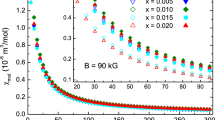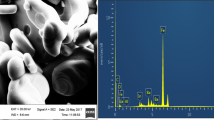Abstract
The electric, magnetic, and physicochemical properties of yttrium barium hydrocuprate (H2YBa2Cu3O7) and its oxidized form (H2YBa2Cu3O7.8) are governed, to a large measure, by poorly studied behavior of hydrogen atoms in the lattice. The crystal chemical state and the mobility of a proton intercalated into yttrium barium cuprate have been investigated by the isotope exchange and inelastic neutron scattering techniques. By their behavior in the process of inelastic neutron scattering, a substantial fraction of protons can be considered mechanically free particles without chemical bonding with oxygen ions. The self-diffusion coefficient of a proton is estimated to be several orders of magnitude larger than that of oxygen ions, the latter coefficient being equal to 10−13 cm2 s−1 at 490 K. Considerable changes in the lattice parameters and local charge distribution in the copper-oxygen subsystem are revealed by the x-ray powder diffraction analysis and nuclear quadrupole resonance (NQR). Discrete changes in the interplanar spacings along the c axis and in the Cu NQR frequencies with a gradual variation in the degrees of hydration and oxidation indicate the formation of hydrocuprate and (or) oxyhydrocuprate in the matrix of the initial material.
Similar content being viewed by others
References
C. W. Chu, D. H. Hor, L. Meng, et al., Phys. Rev. Lett. 58, 405 (1987).
E. K. Shalkova, Yu. M. Baikov, and T. A. Ushakova, Superconductivity 5(1), 22 (1992).
T. Hirata, Phys. Status Solidi 156(2), 227 (1996).
Yu. M. Baikov, Sverkhprovodimost: Fiz., Khim., Tekh. 7(7), 1208 (1994).
Yu. M. Baikov and S. E. Nikitin, Solid State Ionics 86–88, 673 (1996).
Yu. M. Baikov, Zh. Neorg. Khim. 43(1), 22 (1998).
Yu. M. Baikov, S. E. Nikitin, Yu. P. Stepanov, and V. M. Egorov, Fiz. Tverd. Tela (S.-Peterburg) 39, 823 (1997) [Phys. Solid State 39, 729 (1997)].
Yu. M. Baikov and S. E. Nikitin, in Proceedings of the Third International Symposium on Ionic and Mixed Conducting Ceramics, Paris, France, 1997, Ed. by T. A. Ramanarajanan (Electrochemical Society Inc. Proc. 97-24, 1997), p. 390.
. W. Gunther and R. Schöllhorn, Physica C 271, 241 (1996).
R. Borner, W. Paulus, R. Schöllhorn, et al., Adv. Mater. 7(1), 55 (1995).
P. V. Gel’d, R. A. Ryabov, and L. P. Mokhracheva, Hydrogen and Physical Properties of Metals and Alloys: Transition Metal Hydrides (Nauka, Moscow, 1985).
H. Yasuoka, T. Shimizu, T. Imai, et al., Hyperfine Interact. 49, 167 (1989).
I. Heinemaa, H. Lütgemeier, S. Pekker, et al., Appl. Magn. Reson. 3, 689 (1992).
H. Lütgemeier, S. Schmenn, P. Menffels, et al., Physica C 267, 191 (1996).
Ph. Colomban and J. Tomkinson, Solid State Ionics 97, 123 (1997).
Yu. M. Baikov, W. Gunther, V. P. Gorelov, et al., Ionics 4(5/6), 347 (1998).
Yu. M. Baikov, Zh. Neorg. Khim. 43(2), 192 (1998).
Yu. M. Baikov, E. K. Shalkova, and T. A. Ushakova, Superconductivity 6(3), 349 (1993).
M. Yoshimura, S. Inoue, and Y. Ikuma, Solid State Ionics 49, 39 (1991).
K. D. Kreuer, Chem. Mater. 8(3), 610 (1996).
Yu. M. Baikov and E. K. Shalkova, J. Solid State Chem. 97, 224 (1992).
Yu. M. Baikov, B. S. Nikolaev, T. A. Perevalova, et al., Izv. Akad. Nauk SSSR, Neorg. Mater. 24, 615 (1988).
K. D. Kreuer, W. Muench, M. Ise, et al., Phys. Chem. 101(9), 1344 (1997).
J. Tomkinson, Spectrochim. Acta, Part A 48(3), 329 (1992).
Yu. M. Baikov, V. M. Egorov, I. N. Zimkin, and Yu. P. Stepanov, Zh. Neorg. Khim. 42(10), 1620 (1997).
Sh. Edo and T. Takama, Jpn. J. Appl. Phys. 37, 3956 (1998).
H. Glückler, Ch. Niedermaier, G. Nowitzke, et al., J. Less-Common Met. 164–165, 1016 (1990).
W. K. Dawson, C. Boekema, L. Lichti, and D. W. Coone, Physica C 183–189, 1221 (1991).
Author information
Authors and Affiliations
Additional information
__________
Translated from Fizika Tverdogo Tela, Vol. 42, No. 6, 2000, pp. 995–1003.
Original Russian Text Copyright © 2000 by Ba\(\overset{\lower0.5em\hbox{$\smash{\scriptscriptstyle\smile}$}}{l}\)kov.
Rights and permissions
About this article
Cite this article
Baikov, Y.M. Intercalated hydrogen in yttrium barium cuprate: The state and mobility of a “Guest” and modification of the “Host” properties. Phys. Solid State 42, 1026–1035 (2000). https://doi.org/10.1134/1.1131342
Received:
Issue Date:
DOI: https://doi.org/10.1134/1.1131342




